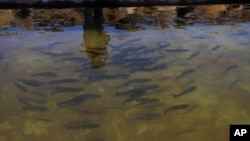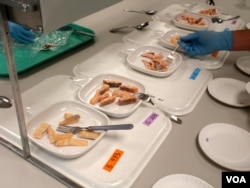PULLMAN, WASHINGTON —
The search is on for a cost-effective alternative to traditional commercial feed pellets given to farmed fish.
Wild-caught fish are a key ingredient in these commercial feeds but that presents a problem because the amount of ocean-caught fish has plateaued while the global aquaculture industry continues to grow.
The U.S. Fish and Wildlife Service is working with fish farmers and university researchers to develop a fishless feed that carnivores, such as salmon, rainbow trout and tuna, will actually eat.
Taste test
That's what brings dozens of taste test volunteers to Washington State University's School of Food Science's test kitchen.
They are presented with three samples of trout - plain, poached pieces of fish that are all alike, except for how they were raised; one was fed fish meal, another ate animal proteins and the third ingested a mostly vegetarian diet.
Some testers report a little bit of "grassy" flavor from what turned out to be the vegetarian-fed trout fillet. The trout raised on traditional fish meal had slightly more fishy flavor and aroma. The trout that ate chicken byproducts did not taste like chicken.
The definition of success in this aquaculture experiment would be for the non-fish alternative diets to yield fish that taste more or less the same as those raised on the current fish-based feed.
"I think they are getting close," said Professor Carolyn Ross, who has been conducting these taste tests since 2008. "Certainly, there are differences between samples, but whether that is a game changer or not is a different question. So yes, I can tell one has a more fishy aroma. I can tell one is firmer. But if you're sitting down at home having a BBQ, it's not going to make a big difference."
Hitting the limit
Aquaculture is a huge industry worldwide, especially in Asia, where the production of farmed fish, eels and shrimp dwarfs the production on all other continents combined. The U.N.’s Food and Agriculture Organization reports that farming of fish that eat pond plants or bottomfeed - like carp, catfish and tilapia - is expanding slower than production of carnivorous species - such as salmon, rainbow trout and tuna. That makes the search for a cost-effective alternative to fish-based feed more urgent.
It's the industry’s number one priority, according to longtime fish farmer Leo Ray of Idaho, the leading trout producing state in the United States. Ray says fish meal that cost $300 per ton about 15 years ago, now runs close to $2,000.
"We knew this was coming," Ray said. "There is a limit on the amount of fish meal the ocean can produce and we've hit that limit."
Ray says the suppliers he buys from have already reduced the wild fish content in commercial feeds somewhat. He and his competitors in southern Idaho have gladly tested all sorts of alternative diets. They've fed their fish poultry byproducts, corn and soybean protein, coconut oil, and ground up insect larvae.
"Salmon are harder to wean off fish meal," Ray said, pointing out that other farmed species, like tilapia, could fairly easily be converted to a plant-based diet. But he doubts going completely vegetarian is the answer.
"We have healthier fish if we put a little bit of fish meal in the diet. I think what we will end up with is a diet that instead of using 20 or 30 percent fish meal, we'll be using five percent fish meal."
The U.S. Fish and Wildlife Service says the effort extends to other aquaculture species as well. Parallel studies are testing alternative feeds for farmed Atlantic salmon and several species of warm water fish. Separate studies by university researchers in Texas and Alabama have investigated plant-based diets for farmed shrimp.
Wild-caught fish are a key ingredient in these commercial feeds but that presents a problem because the amount of ocean-caught fish has plateaued while the global aquaculture industry continues to grow.
The U.S. Fish and Wildlife Service is working with fish farmers and university researchers to develop a fishless feed that carnivores, such as salmon, rainbow trout and tuna, will actually eat.
Taste test
That's what brings dozens of taste test volunteers to Washington State University's School of Food Science's test kitchen.
They are presented with three samples of trout - plain, poached pieces of fish that are all alike, except for how they were raised; one was fed fish meal, another ate animal proteins and the third ingested a mostly vegetarian diet.
Some testers report a little bit of "grassy" flavor from what turned out to be the vegetarian-fed trout fillet. The trout raised on traditional fish meal had slightly more fishy flavor and aroma. The trout that ate chicken byproducts did not taste like chicken.
The definition of success in this aquaculture experiment would be for the non-fish alternative diets to yield fish that taste more or less the same as those raised on the current fish-based feed.
"I think they are getting close," said Professor Carolyn Ross, who has been conducting these taste tests since 2008. "Certainly, there are differences between samples, but whether that is a game changer or not is a different question. So yes, I can tell one has a more fishy aroma. I can tell one is firmer. But if you're sitting down at home having a BBQ, it's not going to make a big difference."
Hitting the limit
Aquaculture is a huge industry worldwide, especially in Asia, where the production of farmed fish, eels and shrimp dwarfs the production on all other continents combined. The U.N.’s Food and Agriculture Organization reports that farming of fish that eat pond plants or bottomfeed - like carp, catfish and tilapia - is expanding slower than production of carnivorous species - such as salmon, rainbow trout and tuna. That makes the search for a cost-effective alternative to fish-based feed more urgent.
It's the industry’s number one priority, according to longtime fish farmer Leo Ray of Idaho, the leading trout producing state in the United States. Ray says fish meal that cost $300 per ton about 15 years ago, now runs close to $2,000.
"We knew this was coming," Ray said. "There is a limit on the amount of fish meal the ocean can produce and we've hit that limit."
Ray says the suppliers he buys from have already reduced the wild fish content in commercial feeds somewhat. He and his competitors in southern Idaho have gladly tested all sorts of alternative diets. They've fed their fish poultry byproducts, corn and soybean protein, coconut oil, and ground up insect larvae.
"Salmon are harder to wean off fish meal," Ray said, pointing out that other farmed species, like tilapia, could fairly easily be converted to a plant-based diet. But he doubts going completely vegetarian is the answer.
"We have healthier fish if we put a little bit of fish meal in the diet. I think what we will end up with is a diet that instead of using 20 or 30 percent fish meal, we'll be using five percent fish meal."
The U.S. Fish and Wildlife Service says the effort extends to other aquaculture species as well. Parallel studies are testing alternative feeds for farmed Atlantic salmon and several species of warm water fish. Separate studies by university researchers in Texas and Alabama have investigated plant-based diets for farmed shrimp.








